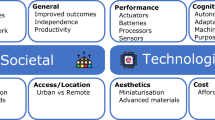Abstract
Portable ramps are generally used by wheelchair users, provide temporary solution to increase accessibility in their daily lives. Portable ramps should allow for modifications in terms of weight, length, load bearing capacity, ease of handling, storage and further design parameters. Different types of portable ramps can be found in the market; however, their modifications cannot go beyond just length modification, or they allow to select just some restricted width options. However, portable ramps are quite suitable for mass customization concept which helps to satisfy customer while being involved in design step. This study aims to determine the wheelchair users’ expectations and correspondingly to offer a smart mass customization design tool which potential users are able to interact with easily. To this end, a case study is conducted with a rollable ramp which is designed and developed within the scope of 1512 – Entrepreneurship Multi-phase Programme (Teknogirişim Sermaye Desteği Programı) of The Scientific and Technological Research Council of Turkey (TÜBİTAK). The methodology and its implementation are described elaborately, and example of a parametric smart customization tool design are illustrated in this study. First, the preliminary study is explained briefly. Afterward, the desired modification parameters are determined with literature and patent survey as well as observation and interviews with the potential users. After systematic review and evaluation of user experiences, the model is assessed.










Similar content being viewed by others
References
Forza C, Salvador F. Product information management for mass customization: connecting customer, front-office and back-office for fast and efficient customization. New York: Springer; 2006.
T. Blecker and G. Friedrich, Mass customization information systems in business. 2007. https://www.igi-global.com/book/mass-customization-information-systems-business/743.
Kratochvíl M, Carson C. Growing modular: mass customization of complex products, services and software. London: Springer Science & Business Media; 2005.
Fogliatto F, Da Silveira G. Mass customization: engineering and managing global operations. London: Springer Science & Business Media; 2010.
Duray R. Process typology of mass customizers. London: Springer; 2011. p. 29–43.
Yoo J, Park M. The effects of e-mass customization on consumer perceived value, satisfaction, and loyalty toward luxury brands. J Bus Res. 2016;69(12):5775–84.
Rincon-Guevara O, Samayoa JA, Deshmukh A. Taxonomy for Classifying Products on the Customization Spectrum. In 2018 International Conference on Production and Operations Management Society (POMS). 2018, pp. 1–8.
Davis SM. From ‘future perfect’: mass customizing. Plan Rev. 1989;17(2):16–21.
James I, Gilmore H, Pine BJ. The four faces of mass customization. Harv Bus Rev. 1997;75(1):91–102.
Da Silveira G, Borenstein D, Fogliatto FS. Mass customization: literature review and research directions. Int J Prod Econ. 2001;72(1):1–13.
Yao X, Moon SK, Bi G. Multidisciplinary design optimization to identify additive manufacturing resources in customized product development. J Comput Des Eng. 2017;4(2):131–42.
Schulz M, Janssen H, Brecher C. Adaptive, connected production of hybrid thermoplastic prototypes. Reinf Plast. 2019;63(1):26–8.
Srinivasan R, Giannikas V, McFarlane D, Thorne A. Customising with 3D printing: the role of intelligent control. Comput Ind. 2018;103:38–46.
Zhao H, McLoughlin L, Adzhiev V, Pasko A. 3D mass customization toolkits design, part I: survey and an evaluation model. Comput Aided Des Appl. 2018;16(2):204–22.
Attaran M. The rise of 3-D printing: the advantages of additive manufacturing over traditional manufacturing. Bus Horiz. 2017;60(5):677–88.
Gardan J. Definition of users’ requirements in the customized product design through a user-centered translation method. Int J Interact Des Manuf. 2017;11(4):813–21.
Verwulgen S, et al. A new data structure and workflow for using 3D anthropometry in the design of wearable products. Int J Ind Ergon. 2018;64:108–17.
Zawadzki P, Żywicki K. Smart product design and production control for effective mass customization in the industry 4.0 concept. Manag Prod Eng Rev. 2016;7(3):105–12.
Liu C, Yao J. Dynamic supply chain integration optimization in service mass customization. Comput Ind Eng. 2018;120:42–52.
Wang Z, Zhang M, Sun H, Zhu G. Effects of standardization and innovation on mass customization: an empirical investigation. Technovation. 2016;48–49:79–86.
Suzić N, Sandrin E, Suzić S, Forza C. Implementation guidelines for mass customization: a researcher-oriented view. Int J Ind Eng Manag. 2018;9(4):229–43.
Xiong Y, Du G, Jiao RJ. Modular product platforming with supply chain postponement decisions by leader-follower interactive optimization. Int J Prod Econ. 2018;205:272–86.
Pine B, Victor B, Boynton A. Making mass customization work. Harv Bus Rev. 1993;71(5):108–11.
Jiao J, Tseng MM. Customizability analysis in design for mass customization. Comput Des. 2004;36(8):745–57.
Jørgensen KA. Product modeling on multiple abstraction levels. In: Mass customization: challenges and solutions. Boston: Kluwer Academic Publishers; 2006. p. 63–84.
Acknowledgements
The work of Tugrul U Daim and as a result this article is partially funded by the Basic Research Program of the National Research University Higher School of Economics (HSE) and by the Russian Academic Excellence Project “5-100".
Author information
Authors and Affiliations
Corresponding author
Ethics declarations
Conflict of interest
The authors declare that they have no conflict of interest.
Additional information
Publisher’s note
Springer Nature remains neutral with regard to jurisdictional claims in published maps and institutional affiliations.
Rights and permissions
About this article
Cite this article
Kumtepe, E.D., Başoğlu, A.N., Corbacioglu, E. et al. A smart mass customization design tool: a case study of a portable ramp for wheelchair users. Health Technol. 10, 723–737 (2020). https://doi.org/10.1007/s12553-019-00400-w
Received:
Accepted:
Published:
Issue Date:
DOI: https://doi.org/10.1007/s12553-019-00400-w




